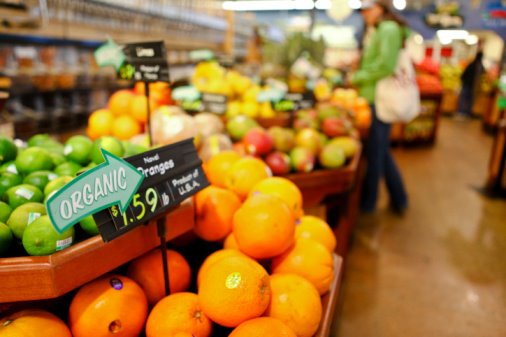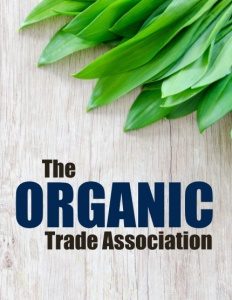The Organic Trade Association (OTA) is a membership-based business association that focuses on the organic business community in North America. OTA is the leading voice for the organic trade in the United States, representing over 9,500 organic businesses across 50 states. Its members include growers, shippers, processors, certifiers, farmers’ associations, distributors, importers, exporters, consultants, retailers, and others. Organic products represented include organic foods, ingredients and beverages, as well as organic fibers, personal care products, pet foods, nutritional supplements, household cleaners, and flowers.
The following is an edited transcript of a written communication between Business View Magazine and OTA CEO and Executive Director, Laura Batcha.
BVM: Can you tell us a little about the history of the Association? What was in the minds of its founders? What was the need that the Association felt had to be filled? Did the mission change over the years?
Batcha: “In 1984, a group of manufacturers, academics, grassroots organizers, and certifiers from the United States and Canada met to discuss the need for a continent-wide organization to help develop a unified, consumer-trusted, market identity for consistent and reliable sources of organic farm products. In February 1985, the Organic Foods Association of North America (OFPANA) was incorporated in Delaware as a non-profit corporation. The original intent was to create a viable organic trade association to advocate for its members.
“The top priority, originally, was to develop a set of unified guidelines for organic standards. The vision was to establish a national definition that could form the basis for a consistent message to the public about the meaning of ‘organic’ on a food label. OFPANA founders envisioned that establishing an endorsement program would address the growing problem of competing certification programs with conflicting organic standards. The intent was to set up a process for evaluating the various certification programs and allowing those that passed to claim the legitimacy of OFPANA’s endorsement.
“Over time, the organization dropped its plan to develop an endorsement program. Instead, it created the important document, Guidelines for the Organic Food Industry, which outlined the certification process to use to verify standards. The open, transparent, and democratic process by which drafts were circulated and approved by the membership was a crucial factor in establishing broad consensus and credibility for the guidelines. This was a key achievement that helped set the groundwork for the Organic Foods Production Act adopted by the U.S. Congress in September 1990 as part of the 1990 Farm Bill, and a major step for the organic sector, as it set up the framework for National Organic Standards.
“With the growing organic food movement, by the end of 1995, OFPANA had changed its name to the Organic Trade Association to better reflect the broad scope of association membership. During the 1990s, the Organic Trade Association expanded its activities, including being involved in the evolution of the benchmark national organic standards published as a final rule in December 2000 by the U.S. Department of Agriculture. Many of the provisions of the final National Organic Program were shaped by the Organic Trade Association’s American Organic Standards–the trade association’s latest iteration of organic standards developed through sector input and consensus.”
BVM: What is the current mandate and vision of the Association?
Batcha: “The Organic Trade Association’s member organic businesses work together through networking, advocacy, and other initiatives to encourage and protect organic farming practices, and to share messages about the positive attributes of organic products with consumers, the media, and policymakers. The Association’s mission is to promote and protect ORGANIC with a unifying voice that serves and engages its diverse members from farm to marketplace. Its vision is to grow ORGANIC to achieve excellence in agriculture and commerce, protect the environment and enhance community well-being.
“The vision of the Organic Trade Association is bold, ambitious, and far-reaching. It is a reflection of the dedication, integrity, and creativity of the sector that we serve, and of our unwavering commitment to lead the organic sector to new unprecedented levels of achievement.
“The opportunities for the organic industry have never been greater. For our Association to lead organic stakeholders – farmers, processors, handlers, retailers – to greater financial profitability, to greater political influence, and to a greater role as the example of agricultural excellence in protecting the environment and producing the highest and safest quality products, OTA is looking 15 years into the future and defining its vision.
“In 15 years, we believe the growing demand in the organic market will continue to outpace supply. This widening gap between supply and demand for organic products sets the stage for a critical era in the growth of organic. With our leadership, the organic supply chain can work together to deliver on the promise of organic to agriculture, the environment, and the public.
“Our vision of an organic industry in 2030, includes market growth, acreage growth, and farming profitability – all healthy and in balance. Demand will be higher, acreage will meet the demand, organic penetration in the market will be deeper, and the influence of organic will be greater.”
BVM: What is your membership? Are there different tiers of membership? Are there any associate members from different industries? How do you communicate with the membership?
Batcha: “Our members represent the entire organic supply chain, and include growers, shippers, processors, certifiers, farmers’ associations, distributors, importers, exporters, consultants, retailers and others. Our members are diversified — from small organic producers to major growers, from local family-run organic operations to nationwide companies.
“One of our strongest assets as an organization is the diversity and breadth of our membership. Between September 2015 and September 2016, we experienced our highest growth in membership in five years, with a total of 216 organic farmers and organic businesses joining, spurred by the growing interest at all levels of the supply chain in the booming organic sector, and the need and desire to be a part of a network of engaged organic stakeholders.
“The formation of our Farmers Advisory Council has continued to swell the numbers of businesses and operations represented by us. The Organic Trade Association’s Farmers Advisory Council is a broad coalition between the trade association and organic farming organizations spread across the country and across various farming sectors. Each organization appoints one producer for each 500 members it represents to serve as its voice in the advisory council’s discussions. In addition to the organizational representatives, organic farmer members of the OTA may volunteer to participate in the council.
“The recent addition of Georgia Organics and the Pennsylvania Certified Organic to our Farmers Advisory Council brought almost another 1,200 certified organic producers in 15 states into our tent.
“We have two categories of membership:
Trade Members govern the association. Only North American-based (U.S., Canada and Mexico) businesses or organizations engaged in the production, distribution, certification, or promotion of certified organic products and the services required to produce them are eligible for Trade Membership. Trade members receive member benefits and one vote.
“Associate Members include businesses, organizations, and individuals who are not eligible for Trade Membership but who are supportive of principles consistent with those of organic agriculture. Businesses and organizations without an office in North America and those who receive no direct sales from the organic industry are only eligible for associate membership. Associate members receive member benefits but do not have voting privileges.
“The association also has a special membership category for small-scale organic farmers. The Farmstead Membership enables smaller organic farmers who have current membership with one of the participating organizations belonging to our Farmers Advisory Council to obtain a full membership with all associated benefits for a minimal fee.
“We communicate often and openly with our members. We publish a three-times-a-year, four-color feature magazine that addresses news and issues affecting the organic sector. We provide a weekly News Flash e-newsletter giving the latest news and items its members need to know. Regular member-wide letters from me, as the CEO/Executive Director, take on topics of vital interest or importance. Special news blasts, frequent press releases that have a wide distribution, sector interest-communications (such as Government Affairs, or International Trade) also are key in keeping members informed. We are active on Social Media, with a Facebook page and a Twitter account, and our staff often tweets live from events such as the National Organic Standards Board. The Organic Trade Association hosts education and informational webinars…and so much more!
BVM: What is the size of the Association’s staff? What are their main priorities?
Batcha: There are 22 people on staff at the Organic Trade Association, with an additional two persons at The Organic Center, an independent 501 (c) 3 science research organization, operating under the administrative auspices of the OTA. Our headquarters are in Washington, D.C., with other offices in Vermont, California, Washington (state), Oregon, and Massachusetts.
“The Organic Trade Association staff works together to catalyze solutions, form coalitions, and collaborate, whether it be on issues before Congress, or on strengthening the organic message and movement to the public. We represent the diverse program of our members to the government — the needs of the organic sector, organic market development and promotion, and strong organic standards and regulations. Addressing critical issues and growing the organic industry are all part of our work together.”
BVM: What does the landscape look like for the industry over the coming decade? How will the Association continue to be a viable voice for the industry?
Batcha: “The organic landscape continues to evolve as it responds to increasing consumer demand for organic products, and not just for organic food, but for non-food organic products as well. Organic will continue to become more a part of the consumer’s daily life, from organic food to organic personal care products and organic clothing and textiles.
“Organic’s retail landscape has expanded far beyond traditional natural and specialty retailers, into conventional grocers and mass-market stores. Organic is now firmly established in mainstream channels and its presence in these channels will only get stronger in the coming years. New retailer opportunities, already emerging, will likely strengthen over the coming decade, such as convenience stores and traditional pharmacies increasing their ‘healthier-for-you spaces’ and organic offerings. Online retailers will continue to expand their offerings of organic products. The purchase of Whole Foods by Amazon this year will almost certainly boost online organic.
“On the production side, organic farming will continue to slowly, but steadily, expand into new areas, and into organic crops in high demand, like grain and soy crops used in organic feed grains. Organic urban gardens will continue to proliferate. Organic will continue to attract young and beginning farmers as a viable, profitable, and environmentally friendly alternative to conventional farming.
“The Organic Trade Association will stay a viable voice for the industry by continuing to engage with its membership to respond to the changing needs and challenges of the industry. The Association keeps its finger on the pulse of the industry, and is regarded as the premier source of information about organic. The more we know about organic, the better we can serve our members.”
BVM: In summation, what are the salient points that you would like our readers to take away from this message?
Batcha: The Organic Trade Association’s Core Values Statement, which explains that members of the Organic Trade Association:
- Have established organic trade on a foundation of common organic standards
- Work in harmony with the environment, promoting sustainability
- Recognize the need for organic agriculture to be economically viable
- Work to protect the diversity of life
- Recognize the interdependence of all parts of the organic community
- Understand that organic farms are the foundation of the organic industry
- Seek out and use whole system approaches to agricultural and business practices, and
- Support the human right to knowledge and choice in the marketplace.
AT A GLANCE
WHO: The Organic Trade Association
WHAT: A membership-based business association that focuses on the organic business community in North America.
WHERE: Washington, D.C.
WEBSITE: www.ota.com


